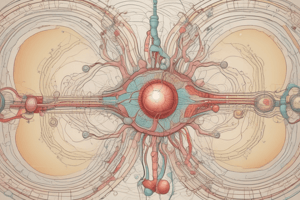Podcast
Questions and Answers
What is the primary function of the negative feedback mechanism in hormone regulation?
What is the primary function of the negative feedback mechanism in hormone regulation?
- To maintain hormone balance and inhibit further hormone release (correct)
- To stimulate uterine contractions during childbirth
- To amplify hormone production in response to a stimulus
- To regulate hormone release from the hypothalamus and pituitary gland
Which of the following is an example of positive feedback in hormone regulation?
Which of the following is an example of positive feedback in hormone regulation?
- Inhibiting hormone release through negative feedback
- Regulating hormone release through the HPA axis
- Stimulating uterine contractions during childbirth (correct)
- Maintaining glucose levels through insulin regulation
What is the term for hormone inhibition within the same gland?
What is the term for hormone inhibition within the same gland?
- Ultrashort-loop feedback
- Short-loop feedback (correct)
- Long-loop feedback
- Positive feedback
Which of the following factors influences hormone regulation?
Which of the following factors influences hormone regulation?
What is the role of the suprachiasmatic nucleus (SCN) in hormone regulation?
What is the role of the suprachiasmatic nucleus (SCN) in hormone regulation?
What is the term for the process by which a hormone inhibits its own release within the same cell?
What is the term for the process by which a hormone inhibits its own release within the same cell?
Flashcards are hidden until you start studying
Study Notes
Hormone Regulation
Negative Feedback Mechanism
- A self-regulating process to maintain hormone balance
- Involves a feedback loop to control hormone production
- Stimulus (e.g., low hormone levels) triggers hormone release
- Hormone levels rise, and the feedback loop is activated
- Feedback loop inhibits further hormone release
- Hormone levels decrease, and the cycle repeats
Positive Feedback Mechanism
- Amplifies hormone production in response to a stimulus
- Rarely occurs in the endocrine system, except in specific situations
- Example: childbirth, where positive feedback stimulates uterine contractions
Hormone Regulation Pathways
- Short-loop feedback: Hormone inhibits its own release from the same gland
- Long-loop feedback: Hormone inhibits its own release from a different gland or the hypothalamus
- Ultrashort-loop feedback: Hormone inhibits its own release within the same cell
Factors Influencing Hormone Regulation
- Neurotransmitters: Regulate hormone release from the hypothalamus and pituitary gland
- Nutrients: Glucose, amino acids, and fatty acids affect hormone regulation
- Stress: Activates the hypothalamic-pituitary-adrenal (HPA) axis, influencing hormone release
- Circadian rhythm: Hormone release follows a daily cycle, influenced by the suprachiasmatic nucleus (SCN)
Hormone Regulation
Negative Feedback Mechanism
- A self-regulating process to maintain hormone balance and prevent overproduction or underproduction
- Involves a feedback loop to control hormone production, ensuring stable levels
- The feedback loop consists of three stages: stimulus, hormone release, and inhibition
- Examples of stimuli that trigger negative feedback mechanisms include low hormone levels, high blood glucose, or high blood pressure
Positive Feedback Mechanism
- A rare mechanism in the endocrine system that amplifies hormone production in response to a stimulus
- Generally occurs in specific situations, such as childbirth, where it stimulates uterine contractions
- Can also be seen in lactation, where it stimulates milk production
Hormone Regulation Pathways
Feedback Loops
- Short-loop feedback: A hormone inhibits its own release from the same gland, preventing overproduction
- Long-loop feedback: A hormone inhibits its own release from a different gland or the hypothalamus, providing a more complex regulation pathway
- Ultrashort-loop feedback: A hormone inhibits its own release within the same cell, providing a localized regulation mechanism
Factors Influencing Hormone Regulation
Environmental Factors
- Nutrients: Glucose, amino acids, and fatty acids affect hormone regulation, with glucose being a key player in regulating insulin and glucagon
- Stress: Activates the hypothalamic-pituitary-adrenal (HPA) axis, influencing hormone release, particularly cortisol and adrenaline
- Circadian rhythm: Hormone release follows a daily cycle, influenced by the suprachiasmatic nucleus (SCN), which responds to light and darkness
Neurological Factors
- Neurotransmitters: Regulate hormone release from the hypothalamus and pituitary gland, with neurotransmitters like dopamine and serotonin playing a role in hormone regulation
Studying That Suits You
Use AI to generate personalized quizzes and flashcards to suit your learning preferences.




